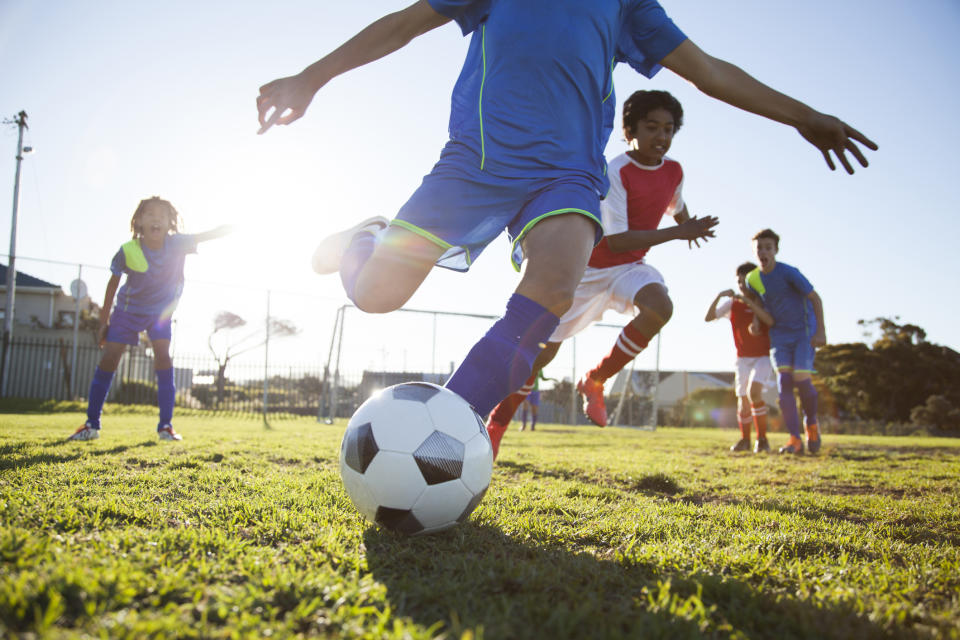Here are the new guidelines for how to handle kids' concussions
With the start of school comes — in most cities — the beginning of a brand new kids’ sports season. And while being part of a competitive team has many proven benefits, there are dangers too. Whether it’s basketball, football, or soccer, many parents — perhaps owing to increased awareness of concussions in the NFL — have begun to express concern over the dangers associated with traumatic brain injuries (or TBIs). At least four states have even proposed laws to ban tackle football in youth.
Is the concern actually warranted — and how can these fears be assuaged? This week, parents have some answers.
In a report published in JAMA Pediatrics, researchers from the University of Calgary, Stanford University, the Cleveland Clinic, and others carried out a “systematic review” of existing data on concussions, then offered not only tips on diagnosing TBIs in youth but also managing and treating them. The researchers relied on national injury data from the Centers for Disease Control and Prevention (CDC) — using a vast window of statistics that ranged from January 1990 to July 2015.
New report by ACHRI and HBI member Dr. Keith Yeates, PhD, outlines 19 sets of recommendations for the diagnosis and treatment of children's concussions, including gradually returning to non-sports activities after 2-3 days of rest: https://t.co/o5WgmFvclV pic.twitter.com/KgcPP53pwQ
— UCalgaryMedicine (@UCalgaryMed) September 5, 2018
What they found allowed them to outline 19 recommendations on the “diagnosis, prognosis, management/treatment of pediatric TBI,” all of which can be found in the report. But before outlining this, it’s important to understand exactly what qualifies as a TBI.
According to the CDC, a traumatic brain injury is defined as “a disruption in the normal function of the brain that can be caused by a bump, blow, or jolt to the head, or penetrating head injury.” Symptoms can range from difficulty thinking clearly to a sudden sensitivity to light; they vary greatly based on the severity of the injury. The Mayo Clinic lists specific symptoms that may appear in children with TBIs, including: unusual or easy irritability, persistent crying, change in attention span, change in sleep habits, seizures, depressed mood, drowsiness, and loss of interest in favorite toys or activities.
Based on the new JAMA study, the problem of TBIs in kids represents a “significant health concern” in the U.S. From 2005 to 2009 alone, over 2 million kids landed in the hospital for TBIs and another 3 million in the emergency department. From 2001 to 2012, the CDC shows, the number of emergency department visits for “sports and recreation-related injuries” resulting in a TBI diagnosis more than doubled for kids 19 and younger. In the U.S. today, 153 people die a day from injuries that include TBI.
So what do the researchers suggest parents do? The recommendations are numerous, and many of them are aimed at health professionals. Here are a few helpful ones for parents.

One, don’t panic and don’t overreact. The researchers say doctors should not default to using magnetic resonance imaging (MRI) or CT scans to diagnose the condition. While they can be useful in serious situations (such as vomiting), they are extremely expensive, often require sedation, and are not always accurate in diagnosing TBIs in pediatric patients. Instead, the researchers suggest that doctors rely on a “validated, age-appropriate cognitive test” as well as a symptom checklist.
Second, the study’s authors suggest that doctors more clearly outline to parents the prognosis for kids who are diagnosed with TBI — specifically, that 70 to 80 percent of children with TBIs do not show significant difficulties that last more than one to three months after the injury. Of course, there are risks for persistent symptoms, and for some that may be a concern, but in the vast majority of cases, patients make a full recovery.
Third, the researchers suggest that doctors instruct patients to “observe more restrictive physical and cognitive activity during the first several days after the injury,” but that — after a few days — they should “resume a gradual schedule of activity that does not exacerbate symptoms.” Rest has long been a “foundation of treatment” for traumatic brain injuries, but the authors cite other evidence showing that physical activity is “beneficial immediately after TBI … for those who are slow to recover.”
Overall the authors hope that the study will bring awareness not only to the risks of TBIs but also to the reality that many are not life-threatening. “We want parents to be aware, and we certainly want them to seek appropriate care,” said Keith Yeates, head of Calgary University’s concussion program as well as one of the study’s lead authors. “But we also want to send the message — and it’s in the guidelines — that the majority of kids recover well and reasonably quickly.”
Read more from Yahoo Lifestyle:
WWE star Nia Jax on how sports gave her confidence: ‘My body had its purpose’
What is A21 and why is Selena Gomez upset it wasn’t covered more in Elle’s piece?
Follow us on Instagram, Facebook, and Twitter for nonstop inspiration delivered fresh to your feed, every day.

